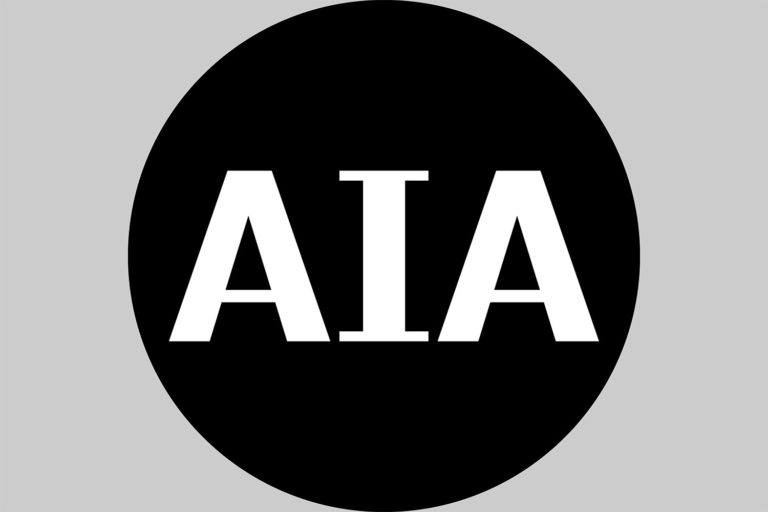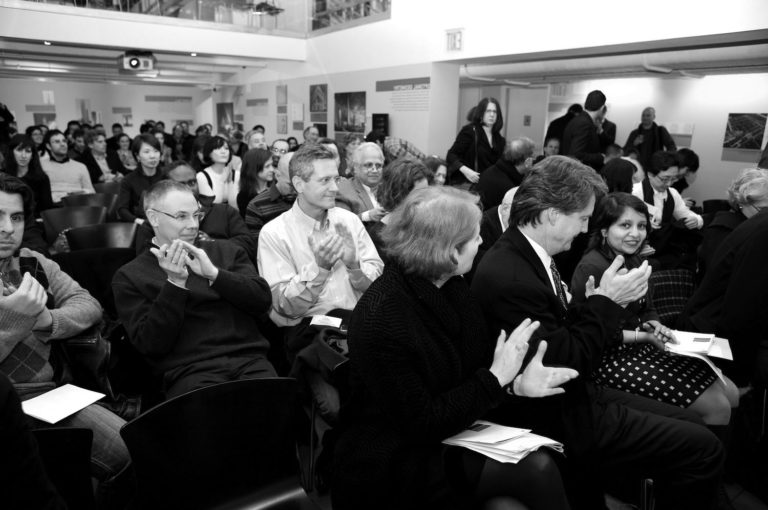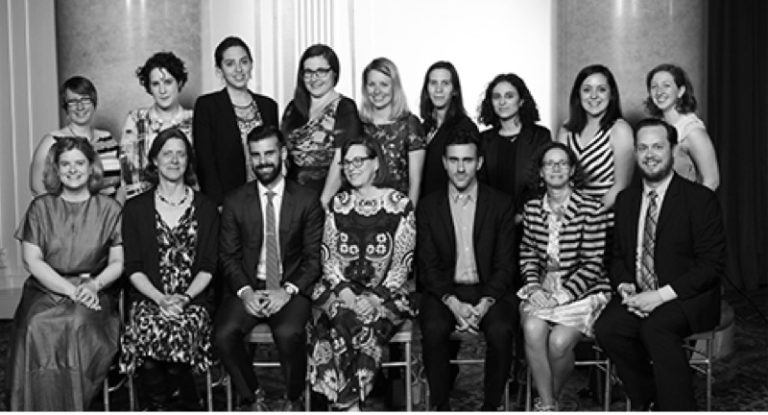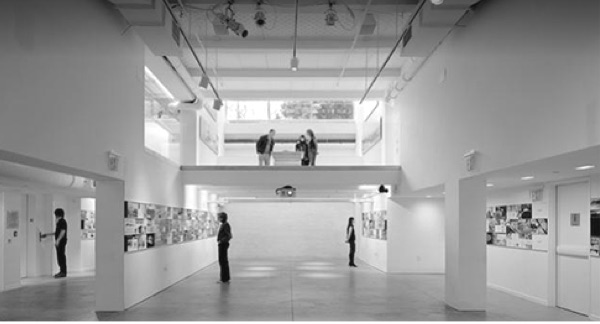by: Linda G. Miller
V&A East Storehouse by Diller Scofidio + Renfro Opens to the Public
Billed as a backstage pass to the Victoria and Albert Museum, the V&A East Storehouse, designed by Diller, Scofidio + Renfro (DS+R), with support from local architects Austin-Smith:Lord, recently opened its doors to the public following 10 years of planning. As part of East Bank, the new cultural quarter in Queen Elizabeth Olympic Park, the new museum experience occupies a large section of the former London 2012 Olympics Media and Broadcast Centre in East London. The over 172,000-square-foot space encompasses four levels and is home to over a half a million works from every creative discipline, ranging from fashion and photography to ceramics, furniture, musical instruments, and pop culture. With “Order an Object,” visitors can browse online, select up to five items, book a viewing, and then see the items they’ve selected up close. From the street-level lobby, visitors pass through a walkway driven through the racks of storage before emerging into the 65-foot tall Weston Collections Hall which contains a cross-section of the V+A’s collections. This clearing in the center of the densely packed warehouse suggests a void extracted from a solid mass. The Collections Hall contains artifacts that appear to stretch into infinitely deep space in every direction—even under foot, through a section of glass floor. The design objective was to create a sublime feeling of the vastness of the collection and, at the same time, a sense of illicit trespass into a space normally unavailable to public view. In response to the needs of the V&A’s curators and conservators, the Collections Hall is bounded by concentric layers of accessibility: the inner layer exposes open crates to the public; the middle layer is a semi-public archive; and the outermost layer contains private spaces for museum staff, conservation work, research, and deep storage, where objects are protected from the dangers of excessive light, dust, and human contact. Effectively, the typical institutional building is turned inside out, with the most public space located farthest from the front door and the most private on the outer edge. Small pockets of space are reserved for back-of-house uses and public functions. Anchoring the Weston Collections Hall are six large-scale objects including the 1930s Kaufmann Office, the only complete Frank Lloyd Wright interior outside of the US, a 15th-century carved and gilded wooden ceiling from the now lost Torrijos Palace near Toledo in Spain, and a full-scale Frankfurt Kitchen designed by Margarete Schütte-Lihotzky, which transformed kitchen design in the 20th century.
SO–IL Creates 3D Knitted Fiber Installation at Venice Biennale
SO–IL, in collaboration with computational architect and structural designer Mariana Popescu and design and research practice TheGreenEyl, created Necto, a 3D knitted installation for the 19th International Architecture Exhibition of La Biennale di Venezia. Billed as “media architecture,” Necto, which will remain on view through November 23, 2025, is suspended between and beyond the columns of the Arsenale Corderie. The project explores the theme of Intelligens through an immersive, innovative, and both computationally derived yet intuitively driven membrane structure that speculates on the future of temporary structures—lightweight, flexible and efficient, and embedded with latent intelligence. Knitted out of linen, flax fiber, and cotton, Necto is computationally optimized and produced in modular strips. Luminous threads integrated within the textile follow selected stress pathways, forming a constellation of light and sound. A series of rings define points of contact, simultaneously shaping the surface and acting as antipoles. Within its undulating geometry emerge three distinct architectural moments: an enveloping cone, a disorienting column, and a hanging mass. Lightweight and portable, the strips arrived on-site in compact luggage and were easily assembled. At the exhibition’s end, it will be flattened and packed ready to embark on its next iteration. During the participant preview (May 7) and pre-opening and opening days (May 8–10), the installation featured a series of performances by Riley Watts, renowned dance artist and educator based in the US, who performed an iterative dance in response to the work, titled “Nectomorph.”
Dattner-designed Atlantic Chestnut to Bring Affordable Housing to Brooklyn’s East New York
The 4.5 acres Atlantic Chestnut, designed by Dattner for Phipps Houses, spans an entire city block bounded by Atlantic Avenue, Euclid Avenue, Fulton Street, and Chestnut Street in the East New York section of Brooklyn. Upon completion in 2028, the 921,000-square-foot project will produce three interconnected mixed-use buildings delivering approximately 1,200 units of affordable housing, ranging from studios to three-bedrooms. A result of the East New York Neighborhood Plan and rezoning effort, the development, which replaces a food processing plant destroyed by fire in 2012, will also offer a grocery store, retail spaces, and a community facility space. Each building in the multi-phase development consists of a 14-story tower and an eight-story volume. The eight-story segments are connected by a continuous metal panel façade that weaves throughout the site, linking the three buildings visually and bridging over grand pedestrian openings along Euclid Avenue. A landscaped “green ribbon” terrace links the three buildings at the ninth-floor roof, featuring a walking path that runs from end to end, with a full two-way loop representing a one-quarter of a mile walk. The landscape design includes coastal dunes, a butterfly garden, hedge rows, and dry meadows. The shared terrace will also include gardening plots for building residents, promoting outdoor recreation and social connectivity. Upper roof levels support additional sustainability and resiliency features, such as solar photovoltaic arrays and a combined heat and power cogeneration system. Landscaped courtyards and a new pedestrian plaza connect residents to outdoor activities and provide attractive routes to building entrances. A new pedestrian plaza named Solidarity Place will link Chestnut St. and Euclid Ave., providing landscaped, off-street entrances to the ground floor apartments and a mid-block focal point for residents to gather or cross through the full-block development site. To date, Phase 1 with its 403 units and Phase 2 with 426 units have been completed. Phase 3 will add 327 units.
nARCHITECTS Re-envisions Teatown Lake Reservation Campus
nArchitects is re-envisioning the campus and buildings of Teatown Lake Reservation, a non-profit education center located on 1,000-acre nature preserve that straddles the towns of Ossining, Yorktown, Cortlandt, and New Castle in the Lower Hudson Valley. The project, expected to break ground this fall, will create an accessible and ecologically enhanced pedestrian campus with reconfigured access and operations. The Education Center will create a new focal point and amenity for the reconfigured campus and provide teaching and educational spaces both inside the building and on its roof. Shaped in the form of a leaf, the 5,400-square-foot, one-story building is wrapped by a ramp that guides visitors from the forest floor to the roof deck, immersing visitors in nature and offering views of the campus and beyond. The campus is anchored by a renovated Nature Center, housed within a 15,000-square-foot 1920’s Tudor-style building that served the original estate as stables. The three-story building is designed to accommodate gallery spaces, a nature store, offices, and an animal care center. The scope of the project also includes a new pavilion and maintenance building. Teatown is home to over 230 native and endangered species of wildflowers and has 25,000 visitors annually. Starr Whitehouse serves as landscape architect.
The Frick Opens New Café by Selldorf Architects, Bryan O’Sullivan Studio
Following its recently completed renovation and enhancement, the Frick Collection recently opened Westmoreland, its first café, an amenity for museum ticket holders and members. Designed by Selldorf Architects, the café seats approximately 50 patrons, is located on the second floor of the expansion, overlooking the 70th Street Garden. It takes its name after the private Pullman train car that the Frick family used from 1911 to travel between their homes across New York, Pennsylvania, and Massachusetts, often taking masterpieces from their collection on these journeys of seasonal relocation. Interior design studio Bryan O’Sullivan Studio (BOSS) conceived the design, which draws inspiration from all three of the museum’s green spaces as well as the historic finishes throughout the mansion. The design references the natural world with floral motifs on the bar surrounds and an overall palette of deep greens and soft pastels. Custom furnishings include walnut tables with brass detailing and upholstered wooden dining chairs, in addition to a polished walnut bar with cast glass finishes. Wall banquettes and tables of four at the center of the room balance intimacy and conviviality. The host station and bar cabinet lend an additional tailored touch shared by the train car. In the foyer, a central settee clad in green mohair serves as a sculptural focal point at the entrance. Artist Darren Waterston was commissioned to create a decorative scheme for the new cafe, nominated by Xavier F. Salomon, the Frick’s Deputy Director and Peter Jay Sharp Chief Curator. Elements include a foyer mural (Fugue), a panoramic frieze (Arcadia), and three bas relief ceiling medallions. These interior features make art historical references ranging from Japanese screens to Renaissance landscape painting, including the Frick’s famed St. Francis in the Desert by Giovanni Bellini. Finishings and features contributed by Selldorf Architects include Nembro Rosato and Breccia Aurora herringbone marble floors and Pietra Bianca di Prun limestone wall cladding. The Murano glass pendant lights match those designed for the museum’s new Reception Hall.
Sotheby’s Announces Herzog & de Meuron’s Plans for Breur Building
International auction house Sotheby’s has announced Herzog & de Meuron’s renovation plans for the Breuer Building at 945 Madison Avenue, which upon completion in Fall 2025, is to become their new global headquarters. The renovation of Sotheby’s New York balances preservation and transformation, ensuring the building, which opened in 1966 as home to the Whitney Museum, remains a vital cultural venue. For the lobby and entry, original materials, including bluestone floors, bush-hammered concrete walls, and dome lights have been preserved; benches and counters reinterpreted as vitrines and display platforms, integrating function into Marcel Breuer’s historic design language; freight elevators have been relocated to open up the entry sequence and improve ADA accessibility; and enhanced exterior lighting under the canopy and cantilever revives the building’s theatrical presence on Madison Avenue. In addition, on the upper floors, former office spaces will be restored to original floor-wide galleries. Notably, the building’s distinctive window openings will be reframed as architectural focal points and a pair of windows on the fifth floor, which were blocked off to create offices, have been reopened and restored. Roman and Williams is designing a fine dining establishment for the lower level. The project has been supported by the New York City Landmark’s Preservation Commission (LPC) which designated the Breuer Building as both an individual and interior landmark in May 2025. The building will be publicly accessible, as is Sotheby’s current headquarters on York Avenue.
In Case You Missed It…
Designed by New Affiliates Architecture, CANYON, a new 40,000-square-foot museum and social space at Essex Crossing on the Lower East Side, will reimagine how audiences experience video, sound, performance, and other forms of art. Founded by philanthropist Robert Rosenkranz and helmed by Joe Thompson, the founding director of MASS MoCA, the space will open in 2026.
TF Cornerstone tapped Spectorgroup to transform Carnegie Hall Tower’s amenity spaces. Flanked by terraces on either end, the design was inspired by the formal garden where pathways carve through cultivated landscapes and unfolds as a series of destinations, each tailored to meet the evolving needs of tenants and visitors alike.
WXY proposes that tactical design interventions, such as reflective surfaces, could improve a sense of safety in New York’s subway system. This is one of the conclusions of What To Do (and Not To Do) About Subway Safety, a new set of policy recommendations from the urban policy journal Vital City.
+ POOL has completed construction of the specialized barge designed to house the filtration system, pool, and on deck amenities for the 2,200-square-foot rectangular version of the pool which will be installed in the East River at Pier 35 in May 2026. The barge will be towed from a shipyard in Mississippi to New York to be retrofitted into the world’s first water-filtering floating swimming pool, once health agencies have approved the final design of the facility. Like a giant strainer dropped in the river, + POOL filters river water within its walls, removing bacteria, contaminants and odors, leaving only safe, swimmable water. The organization has worked with engineers at Arup on the structure’s mechanics and filtration systems and ecological consultants at One Nature to maximize + POOL’s benefit to the environment. In addition, the group worked with Columbia University’s Lamont-Doherty Earth Observatory, innovation designers at IDEO and naval architects Persak & Wurmfeld.

























